The exam will be held in 2026 (এটা 2026 সালের এক্সাম এর জন্য সাজেশান)
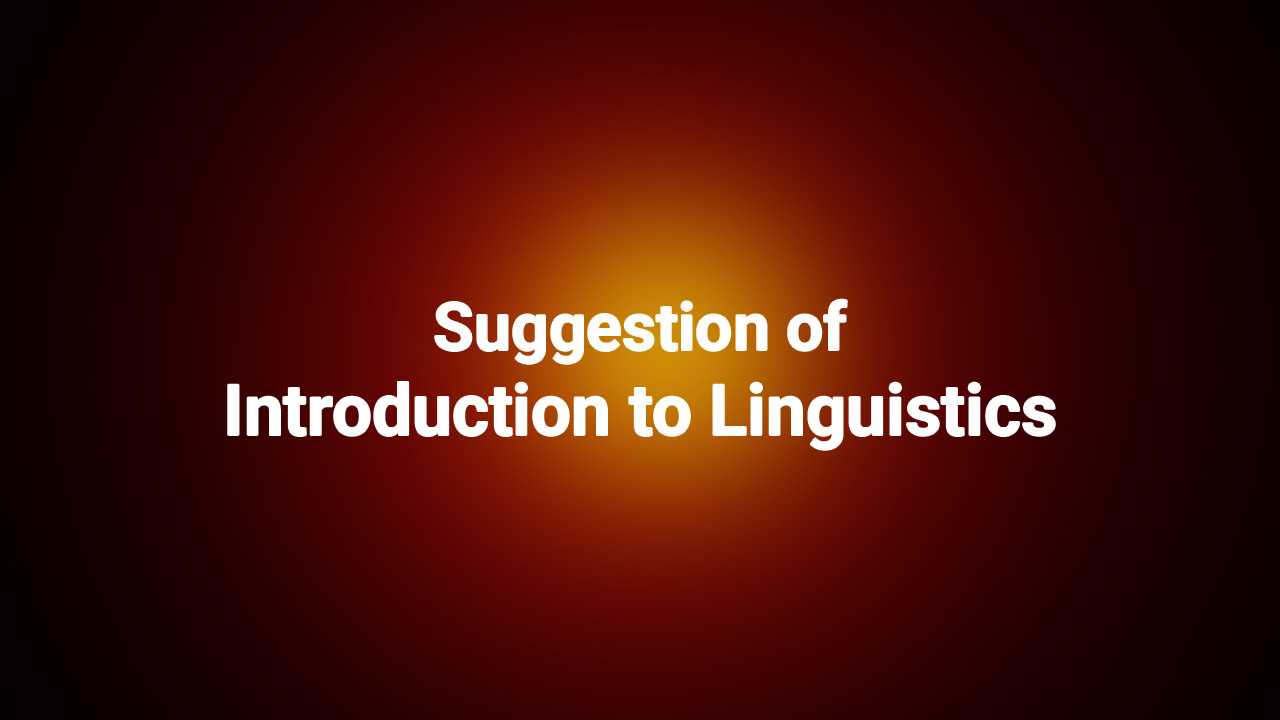
💥3rd year – Paid Online Course
Full Course: 250+ Recorded Live classes
Lecture sheets, Handnotes
Fee: 2000/- এককালীন পেমেন্ট
ভর্তির নিয়মঃ
এককালীন ফিঃ 2000/- টাকা (পরে আর কোন প্রকার টাকা দিতে হবে না)
কি কি পাবেঃ
@ ২৫০+ রেকর্ডেড লাইভ ক্লাসের ভিডিও
@ লেকচার শিট (এটা পড়লে, বই না কিনলেও চলবে)
@ নোটস (ব্রিফ, শর্ট ও ব্রড)
@ ২৪ ঘন্টা সাপোর্ট (০১৭২৬-৭৫৭৯০৮)( কল / হোয়াটস অ্যাপ)
@ টিপস অ্যান্ড ট্রিক্স সুবিধাঃ
@ যখন খুশি তখন ক্লাস গুলো করে নিতে পারবে।
@ একটা নির্দিষ্ট সময়ে লাইভ ক্লাসে জইন করতেই হবে না
@ নেট ইস্যু হবে না, বোরিং লাগবে না
@ 6 মাসের টাকায় সারা বছর পড়তে পারছ—0—
Part – C
Language
- Define language? Discuss the relationship between language and culture
- *** What is language? Discuss the major characteristics/properties of a language.
Concepts of Linguistics
- *** What is linguistics? Discuss linguistics as a science.
- What is a dialect? Discuss the standardization process of a language.
- *** Make a comparative study of behaviourist and mentalist theory of L-1 acquisition.
- *** Who is Chomsky? Describe his contribution to Linguistics. / Competence and Performance.
Phonetics and Phonology
- *** What is Phonetics? Discuss the different branches of phonetics.
- *** Discuss cardinal vowels and show their positions through a diagram.
- *** Discuss the different organs of speech with a diagram.
- *** Classify the English consonant sounds according to the Manner of Articulation.
Morphology
- *** What is morphology? Classify the morphemes in detail.
Syntax
- *** What is PS grammar? Discuss the structure, function, strengths, and limitations of Phrase Structure Grammar. V.V.I
- *** What is the syntax? Discuss the scope/major syntactic processes with a diagram.
- *** What is IC analysis? Exemplify IC analysis through a tree diagram.
Semantics
- *** What is semantics? Discuss the types of lexical relationships.
Pragmatics
- *** What is pragmatics? How is pragmatics different from semantics?
- *** What is the cooperative principle? Discuss with reference to Grecians maxims.
Discourse Analysis
- How does the spoken language differ from the written language?
- *** Show the different stages of child language development.
Psycholinguistics
- *** Explain the nativist theory of Noam Chomsky.
- *** Discuss Ferdinand de Saussure’s contribution to the study of language.
- *** What is Monitor Model Theory of Stephen Krashen? Why is it important in SLA?
Sociolinguistics
- *** Discuss the varieties of sociolinguistics.
—0—
Part – B
- What is Language?
- What is the difference between language, register, and dialect?
- How is language used as a tool for cultural transmission?
- Define Stress and Tone.
Discuss Code Switching.- What are the advantages and disadvantages of oral language?
- What is a semantic relation?
- Discuss the telegraphic speech
What are the differences between competence and performance?- What is PS Grammar?
- What is ‘i+1’?
- What are the functions of intonation?
- What is elision? Mention the rules of elision.
- What are voiced and unvoiced sounds?
- Write a note on Cardinal vowels with a diagram.
- Write a note on syntagmatic and paradigmatic relationships.
- Why is Linguistics considered a Science?
- Describe the language as a social phenomenon.
- Explain the scope and functions of the three branches of phonetics.
- Explain the deep and surface structure.
- How does elision take place?
- What is Assimilation?
- What are Allomorphs?
Distinguish between Free Morpheme and Bound Morpheme.- How do language and langue differ from parole?
- What are zero allomorphs?
- Write a note on LAD.
- What is borrowing?
- What is a signifier?
Discuss English monophthongs with a diagram.- In what sense is language arbitrary?
- Describe different types of articulation.
- What are creole and pidgin?
- Distinguish between cohesion and coherence.
- Distinguish between Phonetics and Phonology.
- What are Triphthongs?
- Differentiate Tone and Pitch.
- What is a grammatical morpheme?
- Define diphthong. Mention the eight diphthongal phonemes of the English language with suitable examples.
- Write a short note on long and short vowel sounds.
- Explain deep and surface structures.
- Write a short note on Phonology.
- Draw the tree diagram according to the phrase structure grammar of “The baby found its mother/The dog followed its master.”
- Transcribe the following words: Knowledge, Village, Southern, Nature, Because, Example.
—0—
Previous Questions
Question of 2023
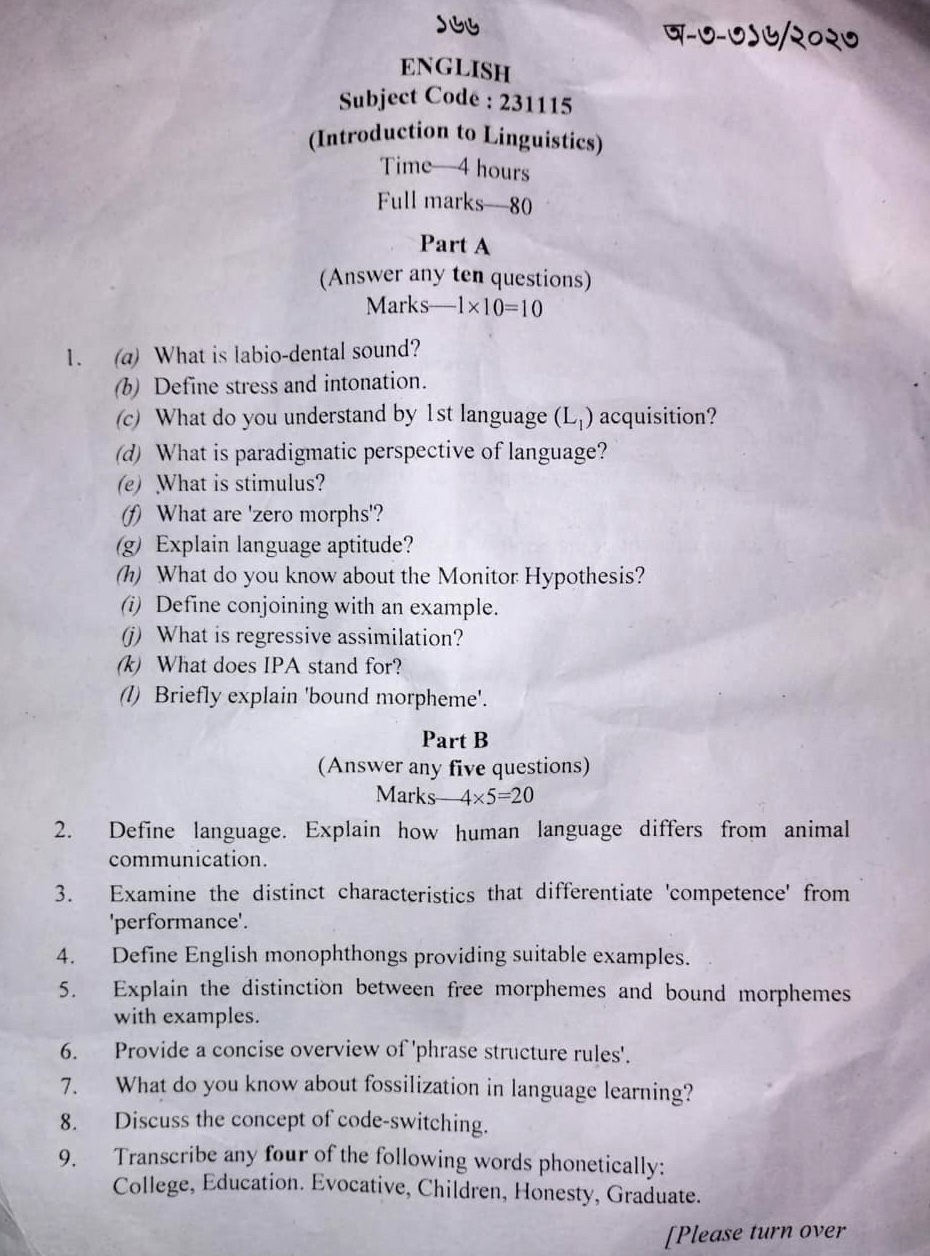
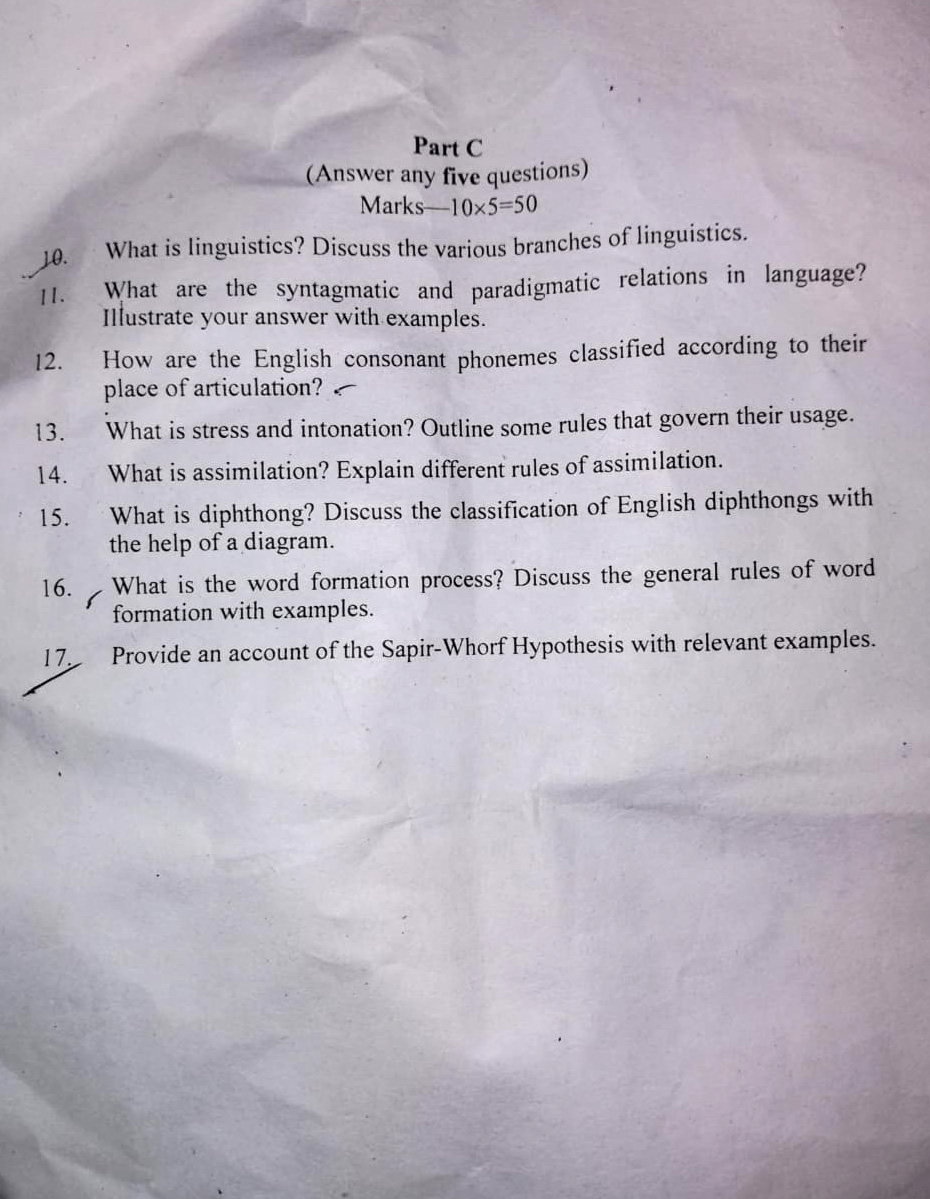
Question of 2022
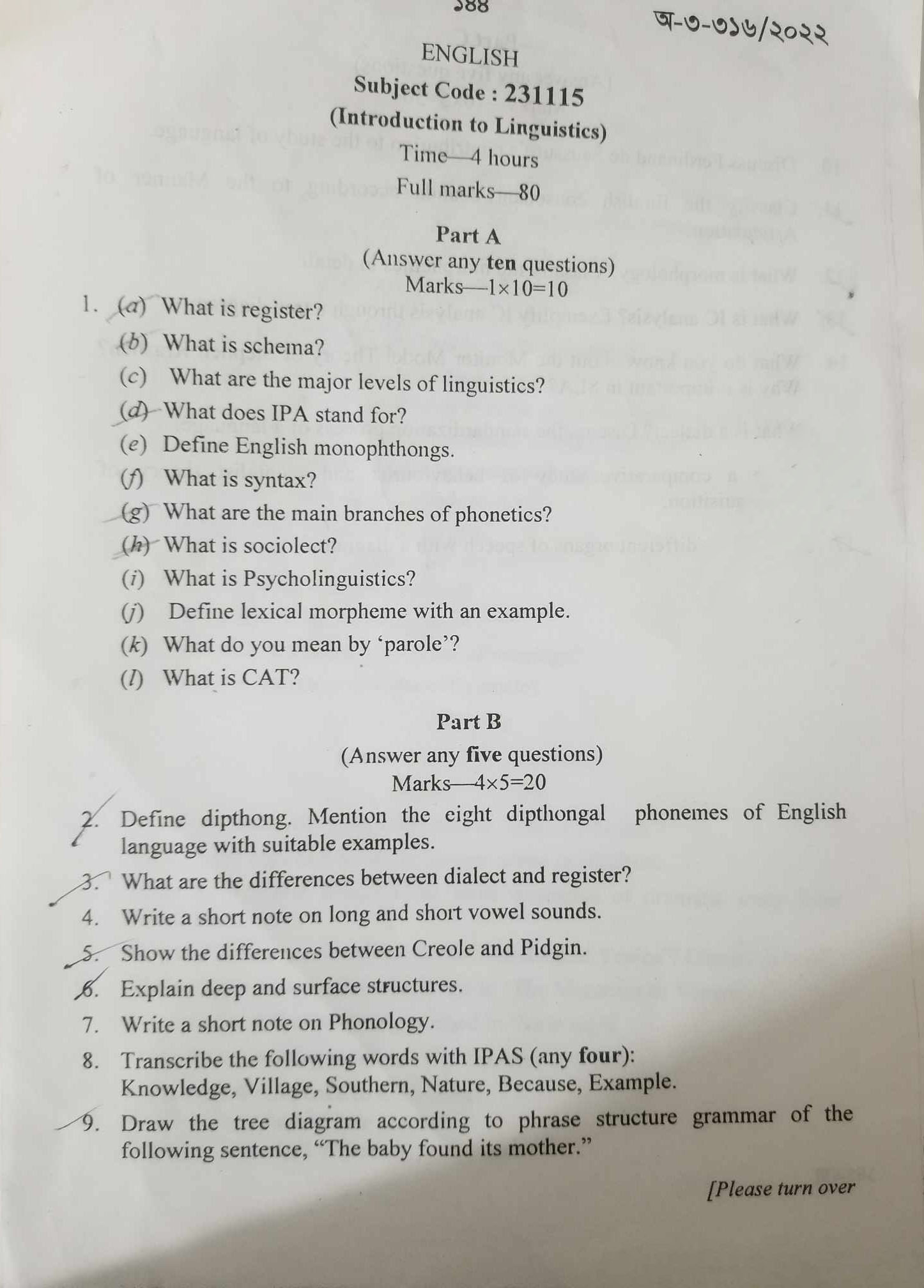
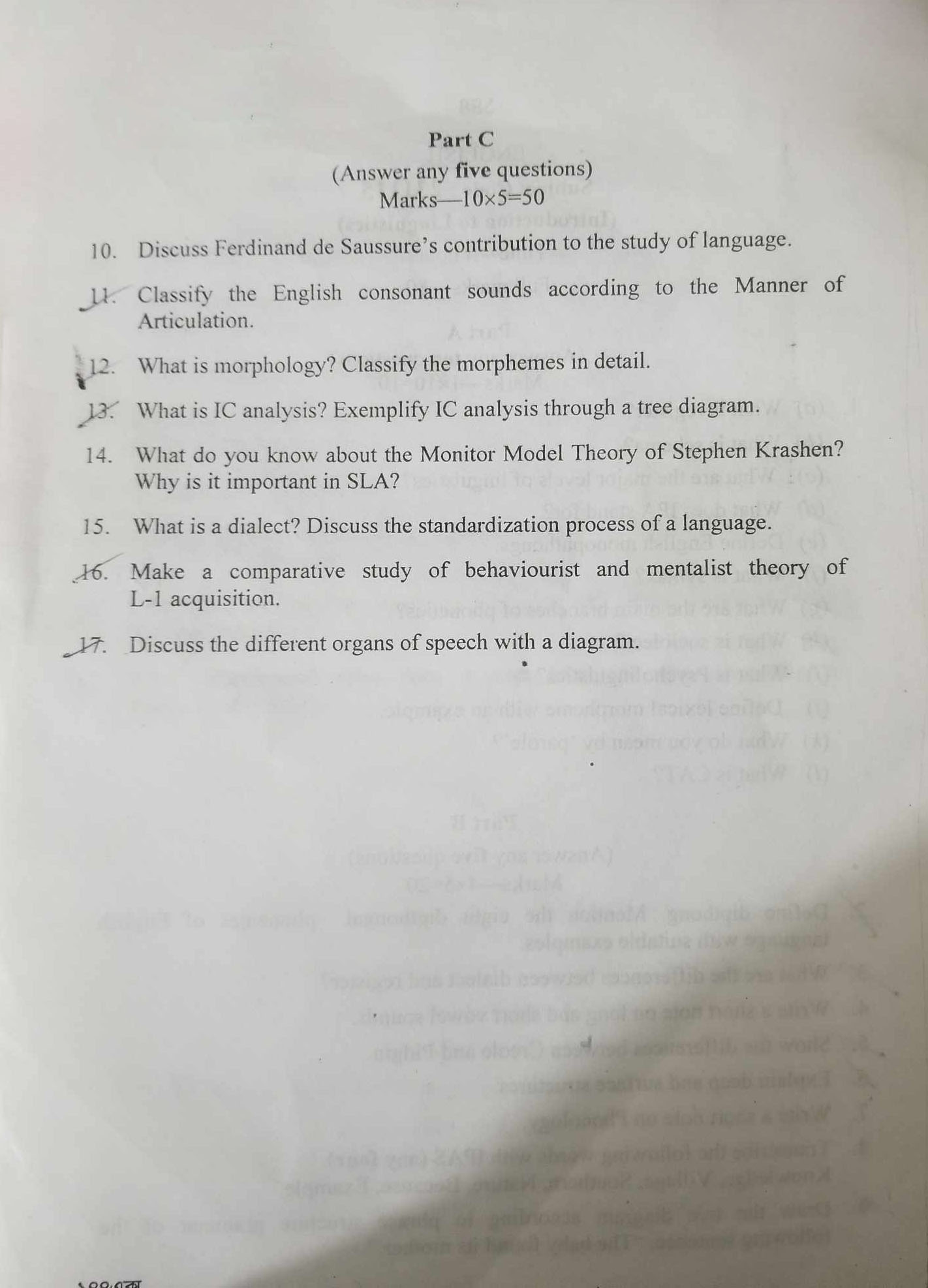
Question of 2021
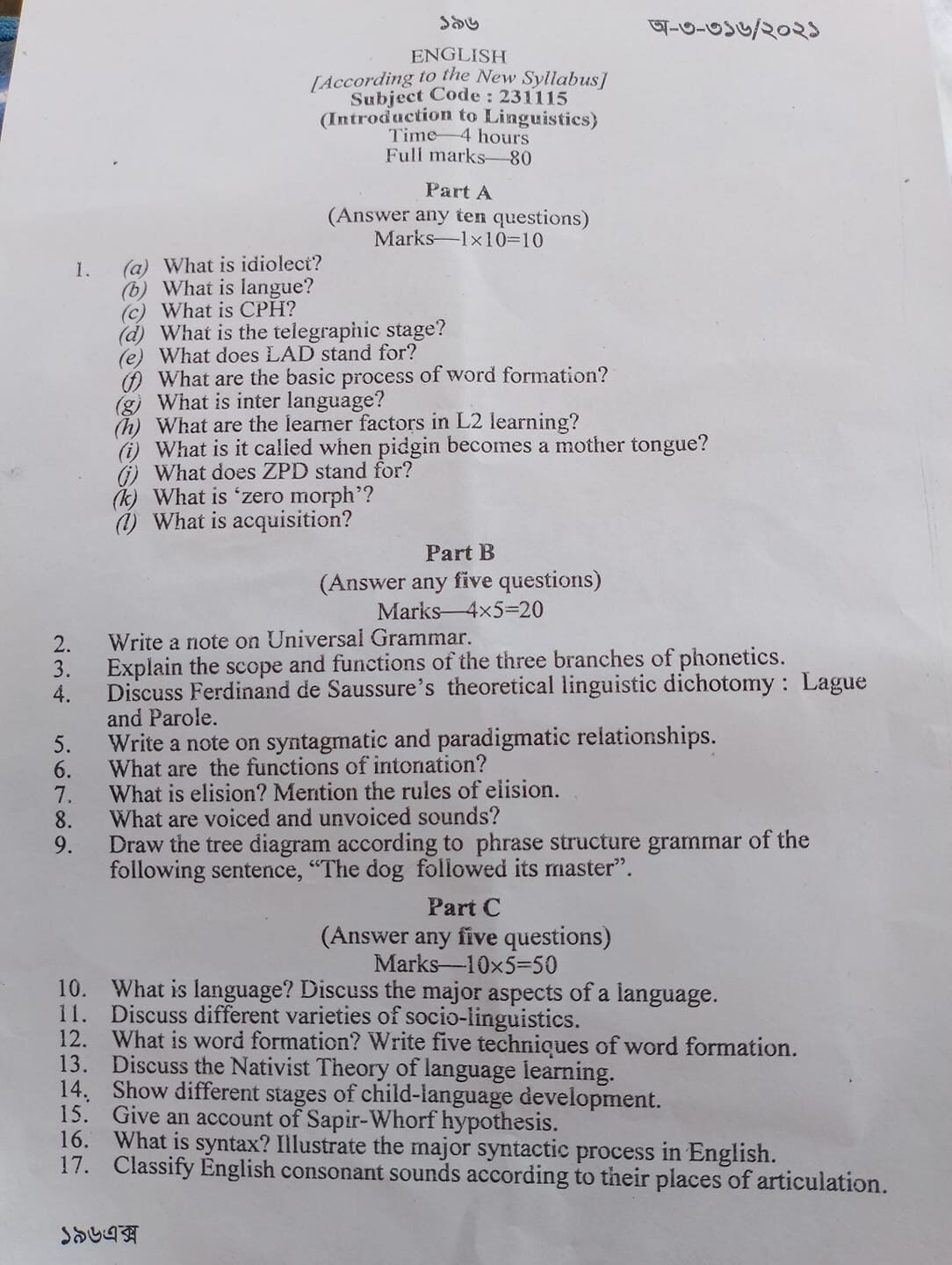
Question of 2020
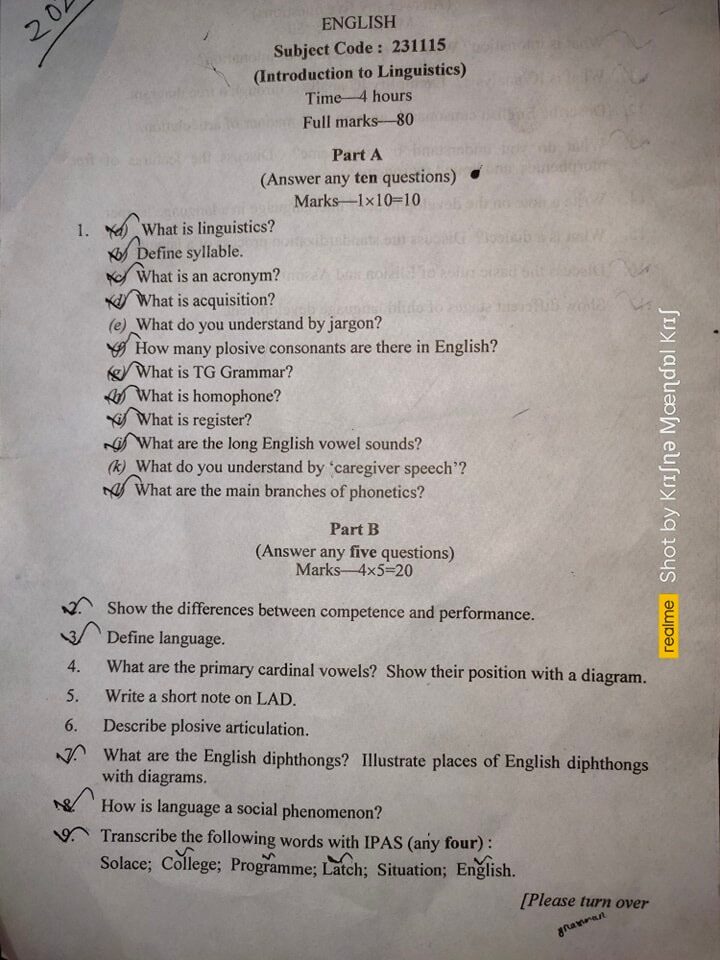
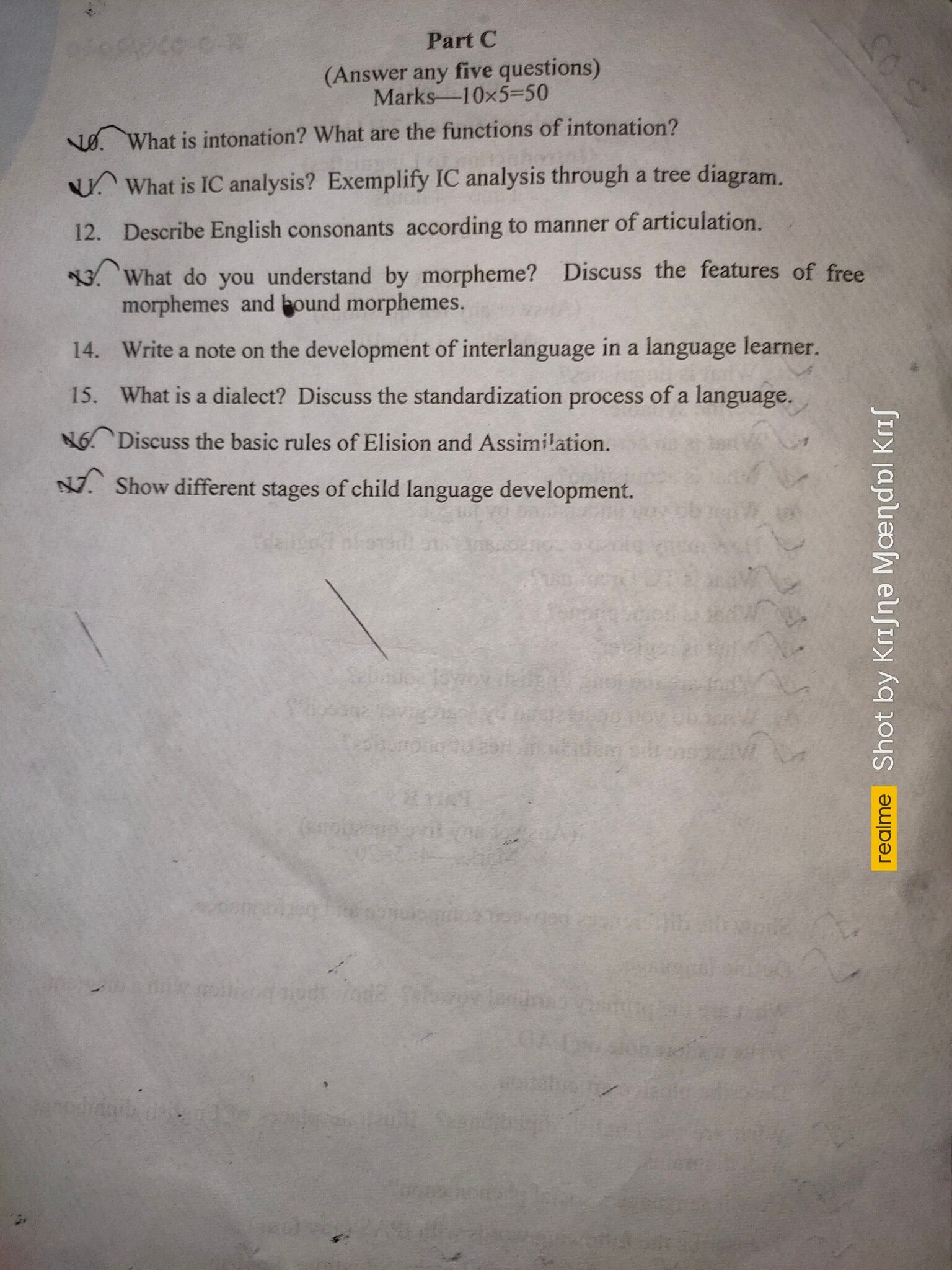
নিচের সাজেশানটা আগের বছরের। উপরেরটা তোমাদের।
Part – C
Language
- What is language? Discuss the major characteristics/properties of a language.
Concepts of Linguistics
- What is linguistics? Discuss linguistics as a science.
- Discuss the scopes/areas/branches of Linguistics.
- Who is Chomsky? Describe his contribution to Linguistics.
- Discuss Saussure’s contribution to linguistics/concept of language and parole.
Phonetics and Phonology
- What is Phonetics? Discuss the different branches of phonetics.
- Discuss different organs of speech for producing speech sounds with a diagram.
- Discuss cardinal vowels and show their positions through a diagram.
- What is stress? Discuss its types and rules of stress placement in English words.
- What is a diphthong? Discuss the classification of English diphthongs with a diagram.
Morphology
- Discuss the different word-formation processes in English.
Syntax
- What is the syntax? Discuss the scope/major syntactic processes with a diagram.
- What is PS grammar? Discuss the structure, function, and limitation of Phrase Structure Grammar.
Semantics
- What is semantics? Provide an analysis of major lexical relations.
- Discuss the types of lexical relationships.
Pragmatics
- What is pragmatics? How is pragmatics different from semantics?
- What is the cooperative principle? Discuss with reference to Grecians maxims
- Discuss the syntagmatic and paradigmatic concepts of language.
Discourse Analysis
- How is the spoken language differs from written language?
Psycholinguistics
- Explain the nativist theory of Noam Chomsky.
- Discuss the Monitor Model Theory of Stephen Krashen for L2 teaching.
Sociolinguistics
- Discuss the varieties of sociolinguistics.
- Give an account of the Sapir-Whorf Hypothesis.
- Discuss the relationship between language and culture.
Part – B
- What is the difference between language, register, and dialect?
- How language is used as a tool for cultural transmission?
- Define Stress and Tone.
- Discuss Code Switching.
- What are the advantage and disadvantages of oral language?
- What is semantic relation?
- Discuss the telegraphic speech
- What are voiced and unvoiced sounds?
- What is PS Grammar?
- Write a note on universal grammar.
- What is ‘i+1’?
- Why Linguistics is considered a Science?
- Explain the deep and surface structure.
- What is elision? Mention its rules.
- How does elision take place?
- What is Assimilation?
- What are the functions of intonation?
- What are Allomorphs?
- Distinguish between Free Morpheme and Bound Morpheme.
- How do language and langue differ from parole?
- What are zero allomorphs?
- What is borrowing?
- Discuss the syntagmatic and paradigmatic relations with examples.
- What is signifier?
- Discuss English monophthongs with a diagram.
- In what sense language is arbitrary?
- What are creole and pidgin?
- Distinguish between cohesion and coherence.
- Distinguish between Phonetics and Phonology.
- What are Triphthongs?
- Differentiate Tone and Pitch.
- What is grammatical morpheme?
—0—
Previous Questions
Part- A (10 Marks)
Brief questions with answers.
Language
1.What is language?
Ans: Language is a communication system of human beings.
2. What is meant by ‘duality’?
Ans: Duality means that language is organized on two levels: physical level and meaning level.
Basic Concepts in Linguistics
3. What is linguistics?
Ans: The science of language is known as linguistics.
4. What are the branches of linguistics?
Ans: Linguistics is three branches: Descriptive, Historical, and Applied Linguistics.
5. What is phonetics?
Ans: Phonetics is the scientific study of sounds of language.
6. What is morphology?
Ans: Morphology is the study of the structure of words, i.g. the study of a minimal meaningful unit of language.
7. What is syntax?
Ans: Syntax is the combination of words into phrases and sentences.
8. What is semantics?
Ans: Semantics is the study of meaning in language.
9. What is pragmatics?
Ans: Pragmatics is the study of meaning in context.
10. What is parloe?
Ans: A term deriving from Ferdinand de Saussure that refers to language as it is spoken, contrast this with langue.
11. What is competence?
Ans: This is the abstract ability of an individual to speak the language which he/ she has learned as a native language in his/ her childhood.
12. What is performance?
Ans: Performance refers to the process of applying one’s competence in the act of speaking.
13. What is discourse analysis?
Ans: Discourse analysis is the investigation of the structure and patterning of discourse.
14. What is competence?
Ans: Competence is the knowledge of the language.
15. Who is Saussure?
Ans: Ferdinand de Saussure is the originator of the 20th-century reappearance of structuralism.
16. What are the major levels of linguistics?
Ans: The levels are: phonetics, phonology, morphology, syntax, semantics, pragmatics, graphology, lexicology, etc.
Phonetics
17. What is a sound?
Ans: A sound is the minimum segment of the pronunciation of a word.
18. What is IPA?
Ans: IPA is a system of transcribing the sounds of languages which consists of some Latin and Greek letters and a variety of additional symbols and diacritics.
19. What is airstream mechanism?
Ans: The air involving the lungs is called the airstream mechanism.
20. What is diphthong?
Ans: In diphthongs, there are two vowels together but only one peak is there.
21. What is larynx?
Ans: It is the main organ referred to as the soundbox. In the larynx, there are vocal cords.
22. What is glottis?
Ans: When the vocal cords create an opening for the air to pass through freely is called the glottis.
23. What is consonant?
Ans: A consonant is a speech sound that is pronounced with the complete or partial closure of the vocal tract.
24. What is Vowel?
Ans: A vowel is a speech sound that is produced without any obstruction in the oral cavity.
25. What is allophone?
Ans: Allophone is the positional variant of the same phoneme.
26. What are the cardinal vowels?
Ans: Cardinal vowels are a system of 8 vowels that was originally developed by English phonetician Daniel Jones.
27. What is the smallest phonetic or phonological unit?
Ans: Phone or Phoneme.
28. What is phone?
Ans: Phone means ‘sound or voice’.
29. How many consonant sounds are there in English?
Ans: There are 24 consonants.
30. What does RP stand for?
Ans: RP stands for Received Pronunciation. 31. What is tonic stress?
Ans: Tonic stress is an extra strong stress on words to show special focus.
32. Define voicing.
Ans: Speech sounds that are produced with the vocal cords vibrating are called voicing.
33. How many vowel sounds are there in English?
Ans: There are 20 vowel sounds in English: pure vowels – 12 and diphthongs – 8.
34. How many monophthongs are there in English?
Ans: There are twelve monophthongs in English. These are – /i:/, /i/, /e/, /ӕ/, /ə/, /ʒ:/, /ʌ/, /a/, /ɐ/, /ɔ:/, /ʊ/, and /u:/.
35. Name the passive articulators.
Ans: The passive articulators are upper lip, upper jaw, teeth ridge, hard and soft palate, and uvula.
36. What are the branches of phonetics?
Ans: There are three branches of phonetics. These are:
- Articulatory Phonetics – Production of speech sounds
- Acoustic Phonetics – Transmission of speech sounds
- Auditory Phonetics – Perception of speech sounds.
37. What are alveolar consonants?
Ans: Alveolar consonants are produced when the blade of the tongue articulates with the alveolar ridge.
38. What are bilabial sounds?
Ans: The sounds made by the two lips are called bilabial. e.g. /m/, /p/, /b/.
Phonology
39. What is tone?
Ans: A tone is a syllable that initiates a contrast in pitch level or direction.
40. What is primary stress?
Ans: The stronger degree of stress is called primary.
41. What is secondary stress?
Ans: The weaker degree of stress is called primary.
42. What is phonology?
Ans: Phonology is the study of the sound system of one or more languages.
43. What is syllable?
Ans: A syllable is a word or part that has one vowel sound.
44. What is stress?
Ans: Stress is the acoustic prominence of a syllable in a word.
45. What is intonation?
Ans: Intonation is a pattern of changing pitch during an utterance to convey linguistic information.
46. What is assimilation?
Ans: Assimilation is a linguistic process by which a sound becomes similar to an adjective sound.
47. What is elision?
Ans: Elision is defined as the disappearance of a sound.
48. What is phoneme?
Ans: Phoneme is the smallest contrastive linguistic unit that may bring about a change of meaning.
49. What is a minimal pair?
Ans: Minimal pair is a pair of two words in a language which differ from each other by only one distinctive sound and which also differ in meaning.
Morphology
50. What is morpheme?
Ans: Allomorphs are the different forms of a single morpheme.
51. What is free morpheme?
Ans: A free morpheme is a morpheme that can stand alone as an independent word.
52. What is bound morpheme?
Ans: A bound morpheme cannot stand alone as an independent word, but must be attached to another word.
53. What is borrowing?
Ans: Borrowing involves copying a word from another language.
54. What is suffix and prefix?
Ans: Suffixes are bound morphemes attached to the end of the word. Prefixes are bound morphemes attached to the beginning of the word.
55. What is a zero allomorph?
Ans: Zero allomorph is an inflection in nouns or verbs presumed to be present although invisible.
56. What is bound stem?
Ans: A bound stem is a stem that cannot occur as a separate word apart from any other morpheme.
Syntax
57. What is syntax?
Ans: Syntax is the study of sentence structure.
58. What are the syntactic units?
Ans: The syntactic units are words, phrases, clauses, and sentences.
59. What is sentence?
Ans: Sentence is the basic unit of syntax.
60. What is deep structure?
Ans: Deep structure is the underlying meaning of the sentence.
61. What is recursion?
Ans: Rules can be applied more than once in generating sentences.
62. What is IC?
Ans: An immediate constituent (IC) is any one of the largest grammatical units that constitute a construction.
63. What does IC stand for?
Ans: IC is an abbreviation of the immediate constituent.
64. What is P-marker?
Ans: The representation of the Phrase structure of a sentence is known as its ‘phrase marker’.
65. What is UG?
Ans: Universal Grammar (UG) is a theory in linguistics. Semantics
66. What is an acronym?
Ans: An acronym is a kind of abbreviation.
67. What is a hyponym?
Ans: When the meaning of one form is included in the meaning of another, the relationship is known as hyponymy.
Pragmatics
68. What is speech acts?
Ans: The philosopher J.L. Austin claims that many utterances are equivalent to actions.
Discourse analysis
69. What is discourse analysis?
Ans: Discourse analysis is the functional analysis of discourse.
70. What is cohesion?
Ans: Cohesion is a grammatical relationship between parts of a sentence essential for its interpretation.
71. What is coherence?
Ans: Coherence is the relationship that links the meaning of utterances and sentences.
72. What is schema?
Ans: Schema is a stored body of knowledge. Psycholinguistics
73. What is Psycholinguistics?
Ans: Psycholinguistics is the study of language with reference to human psychology.
74. What is LAD?
Ans: LAD is a Language Acquisition Device.
75. What is SLA?
Ans: Second-language acquisition (SLA) is the process by which people learn a second language.
76. What is language acquisition?
Ans: Language acquisition is the process by which children acquire knowledge about their native language in their early childhood.
Sociolinguistics
77. What is sociolinguistics?
Ans: Sociolinguistics is the study of the use of language in society.
78. What is idiolect?
Ans: Idiolect is the language of an individual as opposed to that of a group.
79. What is Creole
Ans: Creole is a term used to describe a pidgin after it has become the mother tongue of a certain population.
80. What is accent?
Ans: Accent refers to the pronunciation of a dialect, i.e. it is a reference to the collection of phonetic features which allow a speaker to be identified regionally or socially.
81. What is register?
Ans: A register is a subset of a language used for a particular purpose or in a particular social setting.
82. What is dialect?
Ans: Dialect is any regional, social or ethnic variety of a language.
83. What is isogloss?
Ans: Isogloss is a boundary line between places or regions that differ in a particular linguistic feature such as the pronunciation of a vowel.
Extra
84. What is motivation?
Ans: Motivation is the psychological duality that leads people to achieve a goal.
85. What is first language?
Ans: First language is the native language of the learner.
86. What is clipping?
Ans: Clipping is a process of cutting words into shorter ones.
87. Difine ‘Sign’.
Ans: A sign is something that has a meaning.
88. How does semantics differ from pragmatics?
Ans: Pragmatics is the study of meaning in context. Semantics is the study of the meaning without reference to the context.
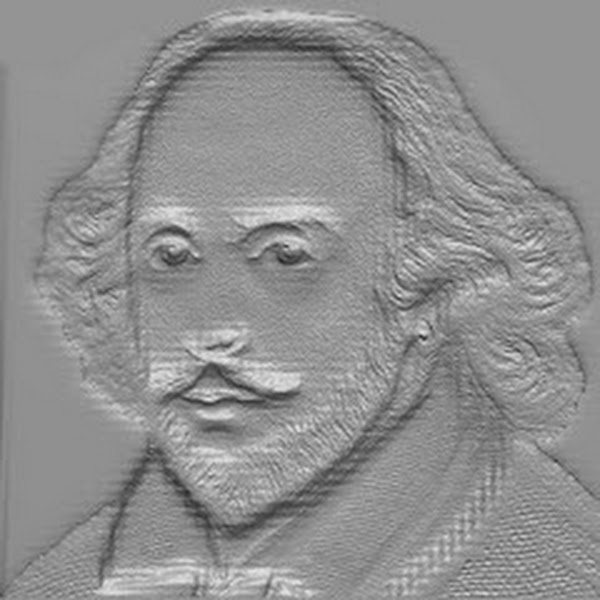 CSP
CSP